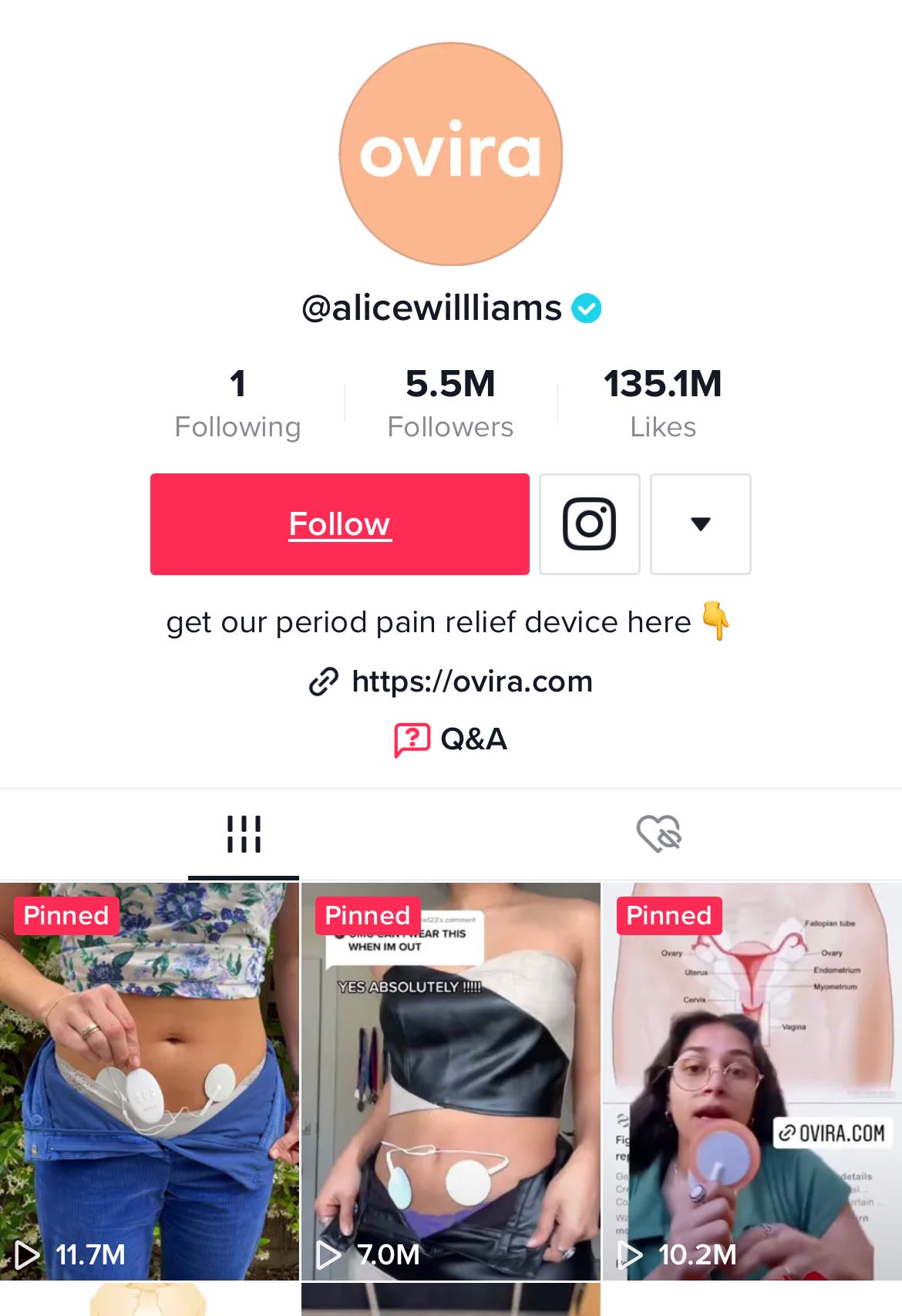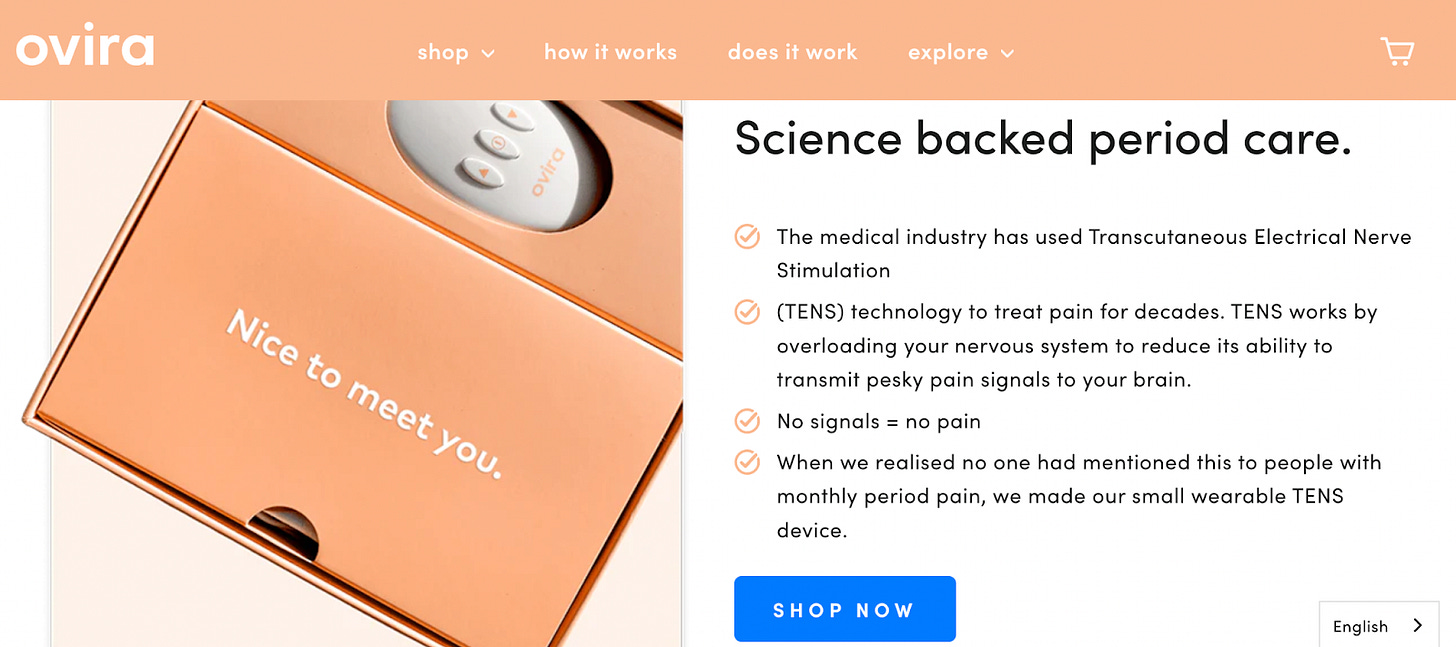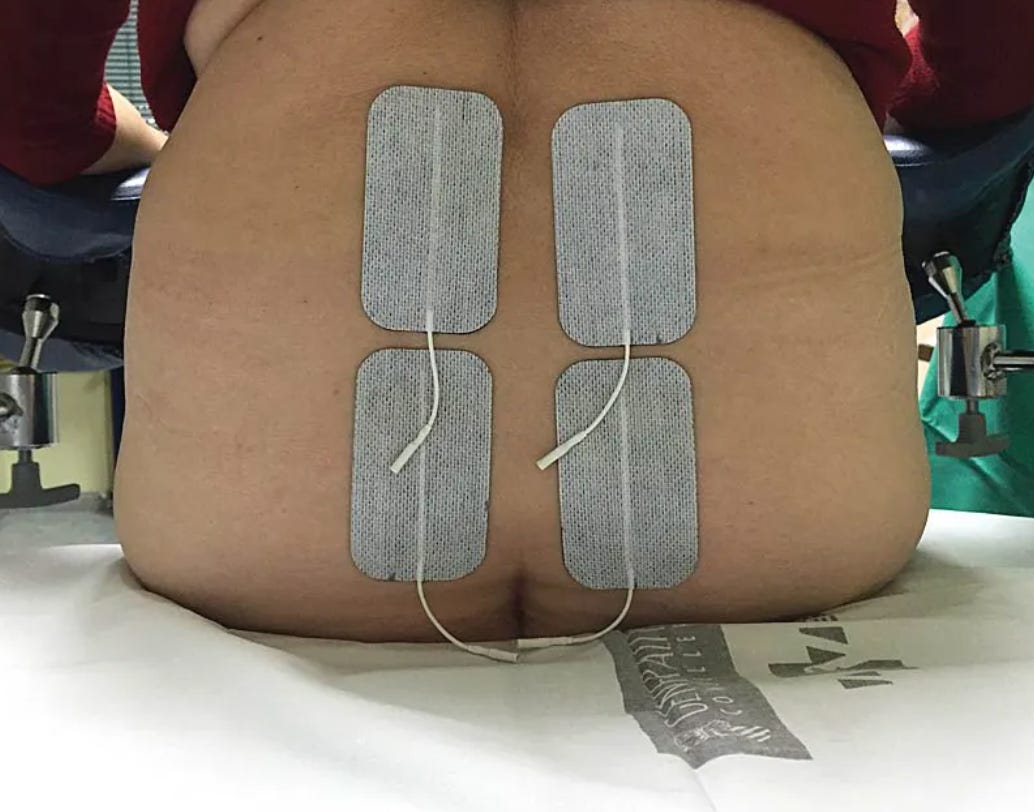How to Use a TENS for Painful Periods
Avoid the Noha by Ovira, it's an inferior product with a hefty pink tax
What I want from my “For You” page on TikTok are videos of rescue kittens, curly hair advice, and some makeup tips for skin over 50 from people who don’t use filters. But given my search history, what I get instead are videos about the vagina and hormones…and not educational ones. It’s all disinformation, and usually from a rogues gallery of people peddling useless products or disgusting men dealing in shame.
Just when I thought things couldn’t get worse, a new low was breached. A video of a chipper woman with a pelvic model inserting a tampon into the rectum, insinuating this is a common mistake, and then explaining that one shouldn’t put the tampon that has been in the rectum into the vagina. The account was Ovira.
I saw many reaction videos from women dumbfounded about this advice. I’ve been an OB/GYN for 30 years and I’ve seen plenty of forgotten tampons in the vagina. It can happen to anyone, even an OB/GYN. There are reports of objects accidentally being inserted into the urethra (even a NuvaRing), but I’ve never heard about a tampon accidentally inserted in the rectum. Might it happen? Of course. But is this so common that people are doing this regularly enough to need advice about not re-inserting the same tampon into the vagina? No. In fact, if this is happening, it’s likely young teens and pre-teens using their first tampons and if your goal is to reach these people, then a very different video would be needed.
And then someone pointed out that this video was a euphemism for anal sex. Look, I try to take people at their word and never did I ever think of being so sophomoric as to use a tampon for an anal sex analogy, I’d just say anal sex and to get around the TikTok purity sensors by changing the spelling. And yes, a penis shouldn’t go directly from the rectum into the vagina without cleaning.
But something seemed very off. The video was cringy, and seemed like an overwrought attempt to get people to look. And of course that is what it was, a sophomoric ploy to create a viral video for an overpriced and inferior TENS unit for period pain made by Ovira.
I HATE a bait and switch. And I HATE a pink tax even more. And I DESPISE people who take advantage of those with period pain.
So here's what the menstruating public needs to know about the Noha and about a TENS unit in general for period pain.
The Noha, made by Ovira, is a TENS unit. That’s it. In the United States it sells for $139.00 and yet you can get a decent TENS on Amazon or from Walmart or Walgreens for $30-40. Meaning the Noha has a $100 pink tax, but it’s worse than that because it’s an inferior TENS.
Let me explain.
TENS stands for transcutaneous electrical nerve stimulation, and it’s a small pager or smart phone-like device (depending on the age of the particular model) worn close to your body that is connected to the surface of the skin via wires and adhesive electrodes. The unit sends an electrical current across the skin to the nerves, but how that reduces pain isn’t truly known. There are several hypotheses, but the main one is that the nerves stimulated by the vibration of the TENS meet at the same point in the spinal cord as the nerves that transmit pain. Vibration travels faster than pain, and so the first signal (vibration) essentially closes the gate for the other signal, dampening or blocking pain. That is why you rub your arm if you bang it–the rubbing is vibration and helps stops the pain signal.
It’s infuriating that the people at Ovira claim that “no one” has mentioned a TENS device for painful periods. A TENS unit is listed as non pharmacological therapy for painful periods in many review papers on painful periods and there is enough literature that it’s been the subject of a Cochrane review. While TENS units are definitely under recommended for period pain, which is an issue, many providers have been talking about them for years. I’ve been recommending them for over 20 years. What Ovira is doing is exploiting gaps in medicine by charging an obscene price for an inferior unit. If they were filling the gap they’d be charging a reasonable price for a good unit.
Also, if Ovira were trying to fill the gap they wouldn’t be making the “no signals = no pain” claim. We have pretty good data showing a high-frequency TENS or hfTENS is helpful for period pain–up to 80% get some relief (I’m assuming the Noha is high-frequency, but I couldn’t find that information on their site, so buyer beware). I tell my patients that hfTENS can take the edge off the pain, because most of the studies report a reduction in pain of approximately 2 on a 11-point (meaning 0 to 10) pain scale. Most people find this a meaningful improvement, meaning going from a 7 to a 5 or an 8 to a 6 etc., especially given the lack of side effects. This is far cry from the advertising from Ovira. Might it work better than a 2 point improvement for some? Of course, just like it might not work at all for others.
The frequency with TENS means pulses per second, and this is measured in Hertz. A high frequency TENS is between 50–120 Hz, but 80-100 Hertz is a typical setting for menstrual pain. The recommended pulse width (duration of the pulse) is typically 50-250 microseconds, and many studies on period pain use 100 microseconds. However, one study that looked at a TENS for reducing pain from procedures on the uterus used a pulse width of 400 microseconds. The final main setting is amplitude or the intensity. It should be set to produce a strong sensation, but should not be painful. In addition to the main settings of frequency, pulse width and amplitude, many TENS units allow you to alter the pattern of the electrical signals, for example, changing the pulses so they come in bursts, with mini breaks.
One big issue with the Noha is it seems there is only the ability to turn the power level up, which I assume is amplitude. Meaning, there is no ability to adjust the frequency or pulse width or to alter the pattern of the pulses. But TENS is like a lot of sensations, people have preferences and some people definitely find they get a better response with different settings, so the inability to make these adjustments is a drawback of the device. In addition, settings for chronic pain are different than for acute pain and I’m assuming the settings for Noha are for acute pain. We recommend acute pain settings for painful periods, but someone with endometriosis and daily pain might want to try a chronic pain settings to see how that works for them, but they can’t do that with a preprogrammed device like the Noha.
Another issue with the Noha is it appears there is only one output wire with two electrodes. Here’s the Noha.
But a better TENS unit for painful periods has two output wires, each with two electrodes allowing you to cover more areas. With four electrodes there are two placement configurations to consider for painful periods. All four electrodes on the back as seen below. The upper electrodes correspond to what we call the T10–L1 level (to cover a group of nerves known as the inferior hypogastric plexus that innervate the uterus) and the lower electrodes to cover the nerves that come out lower down that supply the vagina (this region is S2-S4). For some people menstrual cramps can be from vaginal spasms.
Or the other option is two electrodes on the back, either the upper or the lower position seen above, and the other two on the lower abdomen over the area of pain. The option to place front and back electrodes is really helpful, because many people feel pain in both of these locations. Of course someone could try all four electrodes on their abdomen if they wanted.
It’s not wrong to use a TENS with two electrodes, but it provides fewer options. I always encourage people to get one with four electrodes so they can try different combinations of placement.
Almost everyone can use a TENS with a few exceptions. If you have a pacemaker, implantable defibrillator, heart condition, or epilepsy, check with your doctor before using a TENS. Also, the electrodes shouldn’t be placed over broken or infected skin.
The issues with the Noha are as follows:
Inability to try different settings (meaning stuck with one frequency and pulse width, and no ability to try burst patterns etc.).
Only two electrodes.
Price. Even a high end TENS is still cheaper than the Noha. This one is $122 and is the model used in a study that evaluated a TENS unit for reducing pain from medical abortions (read about the study here). It has four electrodes and the ability to do all the settings anyone might want to try. But there are plenty of well-rated TENS units for much less, for example this one is $32.
What if you are someone who is intimidated by programming a device? Might the Noha be a good option for you? Setting up a TENS unit is easier than downloading and starting many apps. You just need to know the Hertz, pulse width, and the electrode placement (all listed earlier in the article) and that the stimulation shouldn’t be painful. A physical therapist, especially one knowledgeable in the pelvic floor, can help you with the settings and also probably give you other good advice if it seems intimidating.
But does the Noha work? I communicated with Rachelle via Instagram. She was recently diagnosed with endometriosis and told me she saw lots of ads for Noha that targeted the endometriosis community. She explained, “I think the company played into that vulnerable state you are in when you finally get a diagnosis as on average it takes 10 years.” She also said the electrodes lasted 5-8 wears before they stopped sticking and found the replacement pads too expensive. She now uses a different device.
If you want to pay a lot of money for a TENS that has only two electrodes and no option to switch settings, that’s fine. But the people at Ovira are selling an inferior TENS with a big pink tax. This means they aren’t filling the gaps in medicine, they’re exploiting them.
References
Mark Johnson. Transcutaneous Electrical Nerve Stimulation: Mechanisms, Clinical Application and Evidence, Rev Pain. 2007 Aug; 1(1): 7–11.
Goldman AR, Porsch L, Hintermeister A, Dragoman M. Transcutaneous Electrical Nerve Stimuation to Reduce Pain with Medical Abortion. Obstet Gynecol 2021;137:100-7.
Michal Elboim-Gabyzon, Leonid Kalichman. Transcutaneous Electrical Nerve Stimulation (TENS) for Primary Dysmenorrhea: An Overview. Int J Womens Health. 2020; 12: 1–10.
Proctor M, Farquhar C, Stones W, He L, Zhu X, Brown J. Transcutaneous electrical nerve stimulation for primary dysmenorrhoea. Cochrane Database of Systematic Reviews 2002, Issue 1. Art. No.: CD002123. DOI: 10.1002/14651858.CD002123.










I was tickled to see this post today, because coincidentally, earlier I saw an advertisement for a period TENS unit that was bright red and it left me bemused that they felt they needed to make it a special color so everyone knew it was for MENSTRUATION!!! I thought of how you would react and laughed. Anyway, I suspect the tacky color is less objectionable than a big pink tax or an inferior product. Thank you for sharing the information!
Thank you for bringing awareness to these kinds of predatory practices by unscrupulous companies